|
|

|

|
| |
03/2023
|
|

|
|
|
Better Internet for Kids bulletin
Your quarterly update on creating a safer and better internet
|
|
|
|
|
|
|
|
|
|
|
|
|
Editorial
|

|
|
Welcome to the 33rd edition of the Better Internet for Kids (BIK) bulletin. This quarterly bulletin aims to keep you informed of safer and better internet issues and opportunities across Europe and beyond. In each edition, we bring you a mix of news, research and resources from many of the key stakeholders in keeping children and young people safe online, be they European Safer Internet Centres (SICs), research organisations, industry partners, policymakers or other experts in the field.
In each edition of the BIK bulletin, we explore some topical issues. This BIK bulletin’s focus piece features a preview of the forthcoming fourth edition of the Better Internet for Kids Policy Map report. In the focus article below, we zoom in on updates, results and trends identified in this latest monitoring of European BIK policy approaches. And, as a precursor to the publication of the full BIK Policy Map report, we invite you to take a look at a series of country impact case studies - from Ireland, Finland, Malta and Germany - providing policy insights from a national perspective using the collective impact model as an analytical framework.
Also in this edition, we look back at the success of the recent celebration of Safer Internet Day (SID) 2023, which was the 20th edition of the event. We bring you news of SID successes from the European network of Safer Internet Centres and beyond, and updates on many new resource launches which helped to mark the day. We already encourage you to save the date for the next edition of Safer Internet Day - Tuesday, 6 February 2024 - when, once again, we'll unite across the globe... "Together for a better internet".
If you have any comments on this resource or would like to contribute to a future edition of the BIK bulletin, please contact us.
|

|
|
|
|
|
|
BIK Policy Map
|

|
|
BIK Policy Map
|
|

The Better Internet for Kids (BIK) Policy Map is a series of studies that began in 2014 with the aim of mapping policies and activities that support children’s use of the internet and the implementation of the European strategy for a Better Internet for Kids (the ‘BIK strategy’), allowing for comparison and knowledge exchange across the EU. The fourth report of the series will be released in celebration of the one-year anniversary of the BIK+ strategy in May 2023. It constitutes the first BIK Policy Map to report on developments in the 27 EU Member States, Iceland and Norway, since the adoption of the new BIK+ strategy.
BIK+ is the new European strategy adopted by the European Commission in May 2022 to improve age-appropriate digital services and ensure that every child is protected, empowered, and respected online, with no one left behind.
In its fourth edition, the BIK Policy Map provides an insightful snapshot during a time of significant policy change, with the adoption of the BIK+ strategy and the coming into effect of the revised Audiovisual Media Services Directive (AVMSD) as just two of the most recent motions. It presents findings on the policy frameworks and policy-making processes across Europe and maps national activities around the three pillars of the BIK+ strategy: safe digital experiences, digital empowerment, and active participation.
The report processes the contributions and data collected with the support of a network of national contacts comprising representatives of the Expert Group on Safer Internet for Children and Safer Internet Centres in the Member States.
National policy frameworks and policy-making for a better internet for kids
The report refers to policy frameworks as organising principles and long-term goals that unify the multitude of national policies and activities across government departments or ministries supporting children’s digital experiences.
While all participating countries continue to address children’s internet use in policy, and 25 of 29 countries report that the BIK strategy had impacted national policy, only two countries (Ireland and Slovakia) have a single overarching integrated policy framework addressing children’s internet use in place at the national level. Half of the remaining countries indicate that there were several separate dedicated policies in place that address the matters of children online, while the other half reports BIK matters being addressed as part of broader policies.
The report finds that the drawing together of different strands of national policy activities into a common strategic framework remains a challenge for participating countries and hence notes considerable scope at the national level remains to align BIK-related policies in a more cohesive and strategic fashion with children’s rights as a foundation.
In terms of policy-making, the BIK Policy Map report reflects participating countries’ management and coordination of policy, stakeholder involvement in policy governance and the availability of research and evidence supporting policy-making. In 22 of 29 countries, BIK policy matters continue to be coordinated by multiple national bodies. Only three countries report one single body as responsible for all BIK policy (a single government department in the Czech Republic, a public agency in Ireland, and a multi-stakeholder body in Slovakia). In one case, namely Belgium, an alternative mechanism in place includes a nationwide consortium reaching across different federal structures and language groups.
National policy coordination continues to be complex, given the number of ministries involved in policy-making processes. For instance, 25 of 29 countries report that BIK policy-making involves four or more ministries, of which five countries report the involvement of more than six ministries. At the same time, the majority of countries indicate having inter-departmental communication and cooperation mechanisms in place at the national level. With these findings, the trend towards a wider distribution of responsibility for policy development and coordination across more than four government departments or ministries continues.
A shared measurement system, that is the availability of regular data collection at the national level to support policy development on BIK matters, is considered critical for effective decision-making, monitoring and evaluation. The new report finds a continued increase of available research and evidence, with 24 of 29 countries reporting national or regional surveys of children’s internet use within the last three years. In 20 countries, these form part of a regular series of national data collection. In 21 of 29 countries, collected evidence at the national level impacts policy-making. It has influenced policy design, which marks a slight decrease from the last BIK Policy Map report (24 of 30 countries) in 2020.
In the majority of countries (26 of 29), new policy developments, including new BIK topics and issues, have taken place in the past three years, and 20 of 29 countries note that these have, in part, been a response to specific events or concerns at the national level. For instance, in the face of the COVID-19 pandemic, political attention to children’s well-being online, concerns about sexual exploitation and cyberbullying, to name but a few examples, has increased.
Safe digital experiences (BIK+ strategy pillar 1)
Protecting children from harmful and illegal online content, conduct, and risks and improving their well-being through a safe, age-appropriate digital environment continue to be a rapidly evolving area of policy development across the participating countries. Compared to the 2020 BIK Policy Map report, government ministries remain the lead actor of the most relevant actions and measures in this realm, with significant involvement from public agencies and Safer Internet Centres.
Overall, the national delivery of this pillar of the BIK+ strategy is heavily supported across all participating countries, and issues such as age-appropriate privacy settings or parental controls remain key national concerns. However, concurrently, the context for the implementation has changed under legislation such as the General Data Protection Regulation (GDPR), the updated rules for video-sharing platforms with the Audiovisual Media Services Directive (AVMSD), or the enhanced protection of minors coming into effect with the Digital Services Act (DSA).
Given the range of newly implemented and ongoing motions in this respect, the impact of new legislative and policy changes needs to be tracked regularly to safeguard the protection of children online and monitor the development of codes of practice and standards across the EU. Ideally, the monitoring and tracking activities will take place continuously and feed into a central BIK+ Policy Map Index to best inform and guide policymakers on the most up-to-date BIK-related policy developments.
Digital empowerment (BIK+ strategy pillar 2)
This pillar of the new BIK+ strategy is concerned with empowering children with the necessary skills to make safe choices online by comprehensively supporting the development of media literacy and digital skills. This strand of activity is led by Safer Internet Centres in 25 of 29 countries, followed by government ministries and public agencies with BIK responsibilities. In contrast, NGOs, industry, public broadcasters and universities play a supporting or complementary role in most countries across the EU 27 and Iceland and Norway.
Overall, the findings in relation to teaching online safety in schools continue the trend found in the 2020 BIK Policy Map report and illustrate a sustained high priority for online safety education in all participating countries. The same trend continues for the provision of activities and initiatives promoting digital and media literacy across the vast majority of participating countries, both in terms of national education policy, and activities and initiatives carried out by Safer Internet Centres and other national BIK-related stakeholders.
In future efforts, monitoring should closely integrate measures to tackle forms and expressions of the digital divide that affect children’s equal, effective, safe and inclusive access to digital technology. In parallel, a further focus should be on evaluating the latest curricular changes, particularly in relation to equal and inclusive access not just to digital technology per se, but more so to digital empowerment.
Active participation (BIK+ strategy pillar 3)
This pillar of the BIK+ strategy is dedicated to enhancing children’s active participation online with increasing child-led activities to foster innovative and creative digital experiences. Drawing on the EU Strategy on the Rights of the Child, the pillar emphasises the importance of supporting children’s digital citizenship skills. It aims to ensure that children’s voices are not only heard but actively sought out in policy and public decision-making.
The majority of countries (19 of 29) report in this new iteration of the BIK Policy Map that young people are systematically and directly consulted on relevant policy through mechanisms such as hearings, consultations or surveys. This marks a slight increase since the last mapping in 2020 (2020: 17 of 19). When looking at children’s involvement in the development of national public awareness-raising campaigns and activities, 26 of 29 countries report children and young people directly participating in such activities. Regarding their involvement in developing legislation, 14 countries indicate directly involving children in matters that impact their online activities. In contrast, another 13 countries report that there is no involvement of children in the development of new legislation. In terms of fostering high-quality, positive content for children to develop their creativity, the new study finds that 27 of 29 countries have ongoing initiatives that stimulate the production and visibility of quality content for kids online. Even stronger are the countries’ commitments to initiatives at the national level to encourage children’s creativity and promote positive use of the internet (28 of 29 countries).
In general, while high levels of child and youth participation are reported in the vast majority of countries – and Safer Internet Centres are the key actor in facilitating these activities and initiatives – it is rarely the case that children and young people have the possibility to act as decision-makers in policy processes. Instead, participation by proxy is the current standard. Yet, as a newly defined pillar within the new BIK+ strategy, future national development monitoring in this area is critical. Opportunities for children to participate in public decision-making, the implementation of children’s rights across all activities and initiatives, and child-led evaluation are crucial cornerstones to safeguard a better internet for kids rooted in children’s rights.
Outlook
Overall, the BIK Policy Map highlights the importance of a cohesive and integrated approach to BIK-related policies at the national level. It recommends that countries align BIK-related policies more strategically with children's rights as a foundation. The study also suggests future mapping iterations to focus on different policy design and governance models, particularly in the context of new and emerging regulatory structures for the digital environment. By adopting these recommendations, countries can ensure that their policies effectively support children's use of the internet and ensure their safety, empowerment, and active participation.
As a precursor to the publication of the full BIK Policy Map report, we invite you to take a look at a series of country impact case studies providing insights from a national perspective rather than from the point of view of implementing EU strategy. Four countries were chosen as subjects for the case studies: Ireland, Finland, Malta and Germany. Using the collective impact model as an analytical framework, desk research and qualitative interviews were carried out with country experts to identify various features, including policy coordination and design. Formal cooperation mechanisms, and the active participation of children and young people in the policy cycle, among others.
Further information on BIK Policy Map actions and outputs can be found at www.betterinternetforkids.eu/bikmap.
Image credits: zbruch/Getty Images Signature
|

|
|
|
|
|
|
Safer Internet Day roundup
|

|
|
Safer Internet Day 2023 was a great success
|
|
On Tuesday, 7 February 2023, we celebrated Safer Internet Day (SID), with events and activities taking place right across the globe. With a theme, once again, of “Together for a better internet”, the day called upon all stakeholders to join together to make the internet a safer and better place for all, and especially for children and young people.
This edition was particularly special as it marked the 20th anniversary of this milestone event, and served as an opportunity to reflect on the impact of the campaign over the last two decades, as well as the recent important developments in EU legislation, such as the new European strategy for a Better Internet for Kids (BIK+), the Digital Services Act (DSA) and the European Declaration on Digital Rights and Principles.
Vice-President Šuica and Commissioner Breton both acknowledged the day with dedicated video messages addressing children’s digital rights and habits, online opportunities and risks, and the importance of media literacy skills. They urged policymakers, young people themselves, and all other stakeholders involved to gather and continue discussing how to concretely make the internet a better place for children.
In addition, an updated SID video was published to celebrate the day:
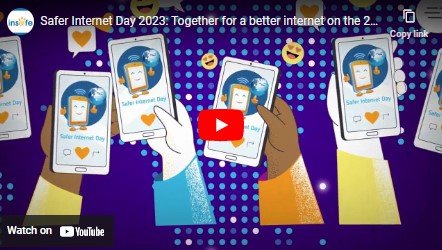
Click on the image to watch the video on YouTube
Visit the news page on the Safer Internet Day website to read about the many successes of the day, and read on to discover more about the various resources and launches which helped to mark the day's celebrations...
|

|
|

|

|
|
European Safer Internet Centres celebrate SID with a range of resources
|
|
The Insafe network of Safer Internet Centres did not hold back when it came to the celebrations of the 20th anniversary of Safer Internet Day. For the occasion, a lot of new resources including lesson plans, videos and other materials were published all over Europe, ranging from materials tackling fake news from the Austrian and German Safer Internet Centres, online challenges from the Italian Safer Internet Centre, and online bullying and abuse from the Irish Safer Internet Centre. Resources aimed at developing the digital literacy skills of younger users were launched by the Cypriot and Portuguese Safer Internet Centres. The Croatian Safer Internet Centre produced a podcast for parents and carers on the topic of sharenting, while the Romanian Safer Internet Centre created a physical place within a school in which children can communicate to discover both new things about the internet, as well as ways to resolve online conflicts.
Find a recap of the most recent network resources on the Better Internet for Kids (BIK) portal.
|

|
|

|

|
|
Global SIC+ partners rally for SID
|
|
The SIC+ (Safer Internet Centre plus) programme is a collaboration between the network of European Safer Internet Centres and like-minded organisations around the world. The programme has three objectives:
- To foster knowledge sharing and capacity building on successful initiatives on online safety for children and young people.
- To promote the development and implementation of innovative actions to increase the participation of third-country organisations in online safety initiatives and best practices.
- To address common challenges in the field of online safety for children and young people by promoting cooperation with the Insafe-INHOPE network, and building on the successful Safer Internet Centre model in Europe combining awareness raising, youth participation, helpline and hotline functions.
Current SIC+ programme members are Armenia, Albania, Bosnia and Herzegovina, Brazil, Colombia, Ghana, Mexico, Moldova, Pakistan, Serbia, South Africa, Turkey, and Ukraine.
SIC+ countries also took part in recent Safer Internet Day celebrations. Serbian SIC+ colleagues organised a conference for Safer Internet Day 2023, with panels on mental health, cyberbullying and first steps in the digital world. In Mexico, many different workshops and events were organised to raise awareness of online risks, including podcasts and live events on TikTok, Instagram and Facebook. In Ukraine, over 45,000 children, young people and teachers participated in local Safer Internet Day activities both offline and online.
SIC+ colleagues in Ghana successfully organised Africa Safer Internet Day 2023. In collaboration with the ITU Regional Office for Africa (the International Telecommunication Union is the United Nations' specialised agency for information and communication technologies) and other partners with similar interests, the campaign was organised to create awareness of Africa’s developing digital ecosystem with the public, and enhance the digital skills and capabilities of young people across Africa. This way, it built on the existing #SID2023 campaign taking account of the new BIK+ strategy also, while reflecting the uniqueness of the African continent. Moreover, for Safer Internet Day 2023, a special hashtag of #ASID2023 was used. To launch the campaign in Africa, an online event was organised where the Safer Internet Day Coordination Team gave a short presentation. The theme of the event was ‘Empowering the African Child on Safer Internet’. Even though Ghana took a lead in organising Africa Safer Internet Day 2023, many other African countries were involved in celebrations.
|

|
|

|

|
|
BIK Teacher corner
|
|
To celebrate this year’s Safer Internet Day, a new BIK Teacher corner was launched. The Teacher corner is a special section of the Better Internet for Kids website aimed at teachers, educators and other adults who work with children and young people. It provides free information, advice, and suggested resources to help to educate and support youth to safely and positively navigate the digital world.
The overall objective of this new resource is to become a one-stop shop and a point of reference for European primary and secondary teachers and educators. It provides a mix of easy-to-digest topical information and hands-on tips and guidance on the evolving nature and range of potentially harmful content, contact, conduct and contract risks that children and young people may experience in the digital world.
This is combined with more in-depth opportunities for learning, exploring key topics in more detail with consideration of the available research evidence, established pedagogical principles and practices, and more elaborate opportunities for interactive classroom exchange. Moreover, it aims to support educators in ensuring that the risks and opportunities of the digital world are taken into account when school policies and procedures are being designed.
A new deep dive article will launch each month on a range of topics, such as sexting and cyberbullying. The latest deep dive article, published to coincide with this edition of the BIK bulletin, focuses on cybersecurity and cybercrime. This is a key aspect of online safety that affects both children and adults; knowing ways to improve security when online and minimise the risks of cybercrime is key.
Read the full article about the BIK Teacher corner, and visit the Teacher corner on the BIK website.
|

|
|

|

|
|
BIK Annual Report 2022
|
|
On the occasion of Safer Internet Day 2023, the Better Internet for Kids Annual Report 2022 was published, reflecting on the main achievements of the past year.
Significantly, 2022 saw the launch of a new European strategy for a Better Internet for Kids (BIK+). Ten years on from the original BIK strategy and founded on extensive consultation with multiple stakeholders – including children and young people themselves – this new strategy frames the steps needed to ensure that all children and young people are protected, empowered and respected online. Many of the actions carried out in the second half of 2022 under the umbrella of the BIK project already uphold the aims of the strategy, or indeed lay down solid foundations for more work to come.
In stark contrast with such positivity, however, 2022 also saw the Russian invasion of Ukraine; an act which shocked the world. Here, within the framework of BIK, the European network of Safer Internet Centres rallied to support all those affected by the situation, whether that be supporting families displaced by war and finding themselves in new, unfamiliar countries, or helping parents, caregivers, and educators to find age-appropriate ways of explaining the events and answering questions children might have, while at the same time protecting them from harmful media experiences. Discover more and download the full BIK Annual Report 2022, and read more about young people's involvement, specifically, in BIK actions during 2022 below.
|

|
|

|

|
|
Child-friendly version of the European Digital Rights and Principles
|
|
The European Commission wants to ensure people are empowered to fully enjoy the opportunities that the digital decade brings. As such, it proposed a set of European digital rights and principles that reflect EU values and promote a sustainable, human-centric vision for the digital transformation of Europe. The resulting declaration was signed by the European Commission, Parliament and Council in December 2022.
On the occasion of Safer Internet Day 2023, a child-friendly version and a videogame, inspired by the European Declaration on Digital Rights and Principles, were launched by the Commission, to help young people better assimilate this piece of legislation.
Similarly, to ensure that children and young people understand and are involved in the decision-making process of the internet of the future, a child-friendly version of the new European strategy for a Better Internet for Kids (BIK+), adopted in May 2022, is also available.
|

|
|

|

|
|
Save the date for Safer Internet Day 2024
|
|

While Safer Internet Day 2023 might be just behind us, we are already looking forward to Safer Internet Day 2024! Save the date for #SID2024 on Tuesday, 6 February 2024.
Campaigning activities will start from September 2023 onwards, but keep checking the Safer Internet Day website at www.saferinternetday.org for the latest news and updates in the meantime.
Image credit: EUN/Safer Internet Day
|

|
|
|
|
|
|
BIK Youth
|

|
|
Listening to YOUth – a series of short videos with young people
|
|
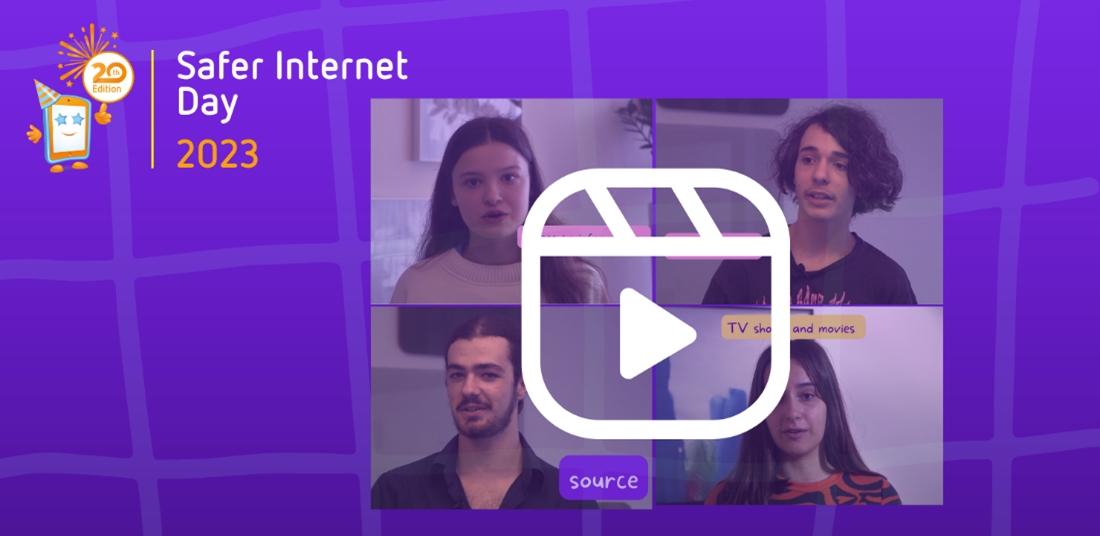
On the occasion of Safer Internet Day 2023, BIK Youth Ambassadors and youth panellists from different European countries were featured in three short videos where they exchanged views on their opportunities online and their perspectives on what would make their digital experiences safer.
Read more and watch the videos on the Better Internet for Kids (BIK) portal.
|

|
|

|

|
|
Shining the light on BIK Youth
|
|
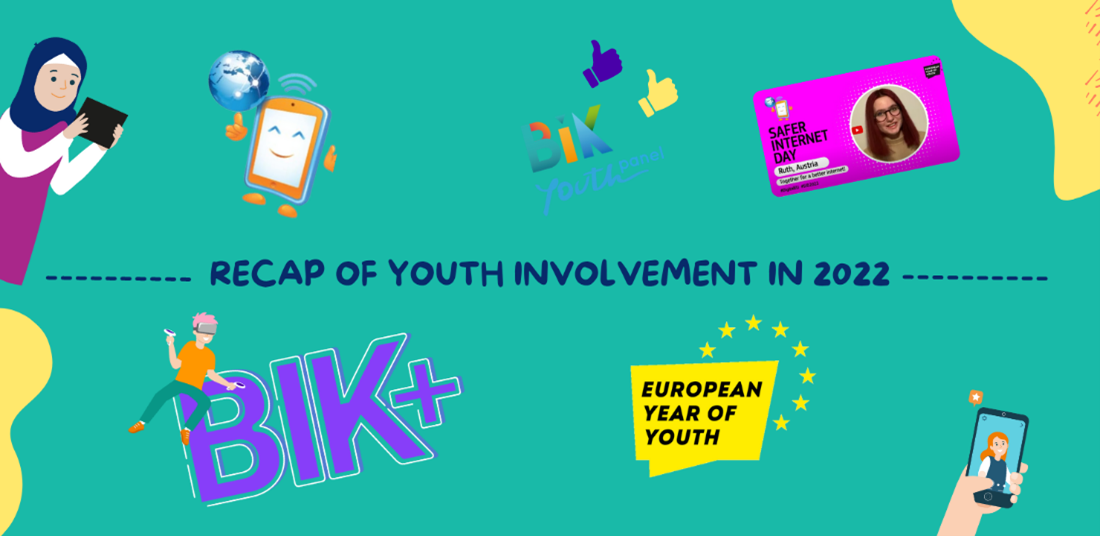
2022, designated the European Year of Youth, was full of events! Many experts came together to discuss how to make the internet better for young people, covering a range of topics. Equally throughout the year, young people themselves showed their commitment to building an environmentally friendly, safe, and inclusive future.
The BIK Annual Report 2022 (see above), published on Safer Internet Day 2023, provided an opportunity to highlight youth involvement in events and activities which included SID 2022, the creation and launch of the new BIK+ strategy (and especially a child-friendly version), a youth-led edition of the Safer Internet Forum (SIF), and youth representation at high-level events, including the Digital Assembly and the Internet Governance Forum (IGF) discussing topics such as fake news and disinformation.
Discover more about youth involvement in 2022 in this child-friendly infographic and visit www.bikyouth.eu to learn more about youth involvement and participation in BIK-related issues in general.
Image credit: EUN/Better Internet for Kids
|

|
|
|
|
|
|
Insafe helplines
|

|
|
Helpline services are in high demand
|
|

The Insafe network of helplines collects data about the types of calls received and this is analysed every three months to look at trends, and new and emerging issues.
The most recent helpline data covers the period from October to December 2022. There were over 18,800 contacts made to the network which continues the upward trend in the number of people who are reaching out to helplines, as has been the case for the last three years. There was an increase of seven percentage points from the previous quarter.
Cyberbullying continues to be the most common reason for contacting a helpline accounting for 16 per cent of all contacts; a rise of two percentage points since the previous quarter.
Contacts relating to sexting, sextortion and online sexual harassment account for 16 per cent of all contacts when combined and, once again, several helplines have cited an increase in sextortion cases in particular. As mentioned in the last BIK bulletin, it was noted that advances in technological evolutions are facilitating criminals who want to benefit from sextortion. When comparing the number of contacts relating to sextortion in 2022 with those received in 2021, there was a rise of 60 percentage points which highlights the scale of this growing problem.
Read more on the latest Insafe helpline statistics on the Better Internet for Kids (BIK) portal.
Image credit: Maria Thalassinou/Pexels
|

|
|
|
|
|
|
INHOPE hotlines
|

|
|
Create digital safety through united action
|
|
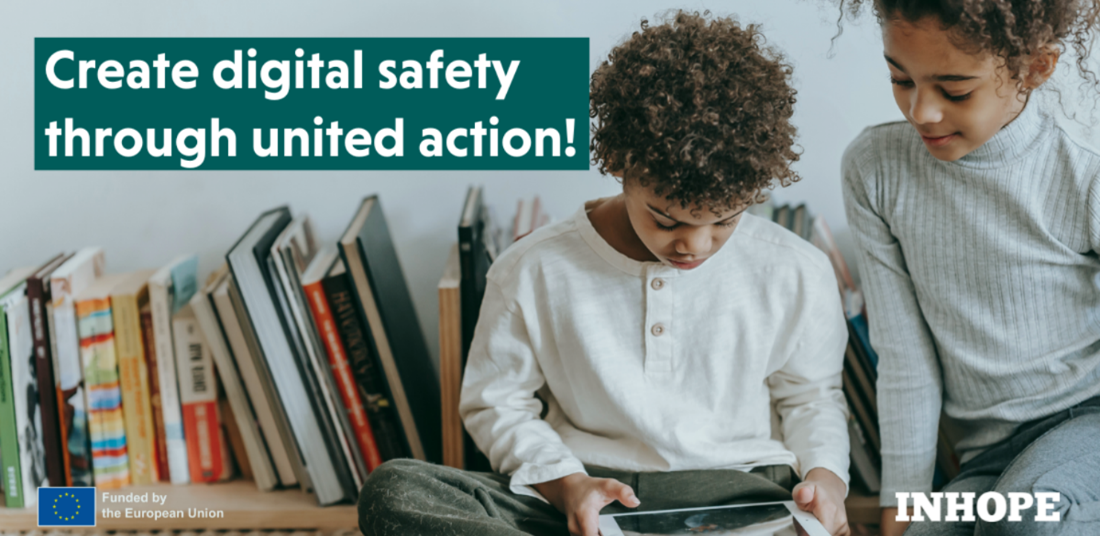
Actions speak louder than words – and with this year presenting two decades of striving for a safer internet, INHOPE looks back on collective action results on the landmark event that Safer Internet Day has become. And, as a global network, INHOPE reflects on its own actions and its impact on the association of hotlines across the years.
More specifically, INHOPE supports hotlines and partner organisations through training, best practices, quality assurance and staff welfare. Safer Internet Day is an opportunity to unite the organisation's message and speak up for the member hotlines.
In its efforts to accomplish its vision of a world free of child sexual abuse material (CSAM) online, INHOPE supports an existing network of member hotlines and encourages the creation of new hotlines worldwide. INHOPE supports hotlines at every stage of their journey, from creation and awareness raising, to establishing a reporting structure, and daily operations. Discover more about their actions.
Read the full article on the Better Internet for Kids (BIK) portal.
Image credit: INHOPE
|

|
|

|

|
|
INHOPE webinar series
|
|
INHOPE has launched its 2023 series of Expert Insights webinars, featuring top industry experts sharing their knowledge and insights on a variety of topics focused on combating online child sexual abuse material (CSAM). These webinars are designed specifically for professionals in the field of online child protection and offer unique access to the newest information relevant to this field.
Find the full agenda and registration information on INHOPE’s website.
|

|
|
|
|
|
|
Courses and resources
|

|
|
Games in Schools MOOC
|
|
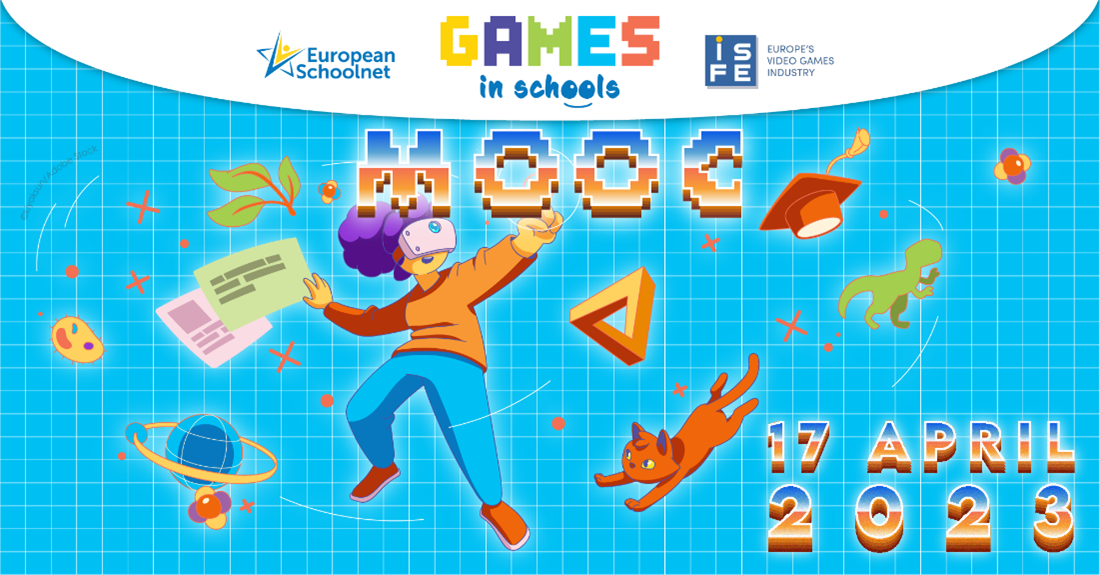
The Games in Schools MOOC (massive open online course) for teachers aims to examine both the opportunities and challenges offered by integrating games into teaching and learning. It will explore topics like playful learning, thematic learning, social and emotional learning, and game design, and will provide practical examples of gaming tools and activities that can be used in daily teaching practice.
The MOOC will launch on Monday, 17 April 2023; learning is at your own pace, but the final deadline to complete all activities is Wednesday, 31 May 2023. Learn more about the learning objectives and modules, and enrol for the course on the European Schoolnet Academy.
Image credit: EUN
|

|
|

|

|
|
Open call for teachers: media literacy co-development session
|
|
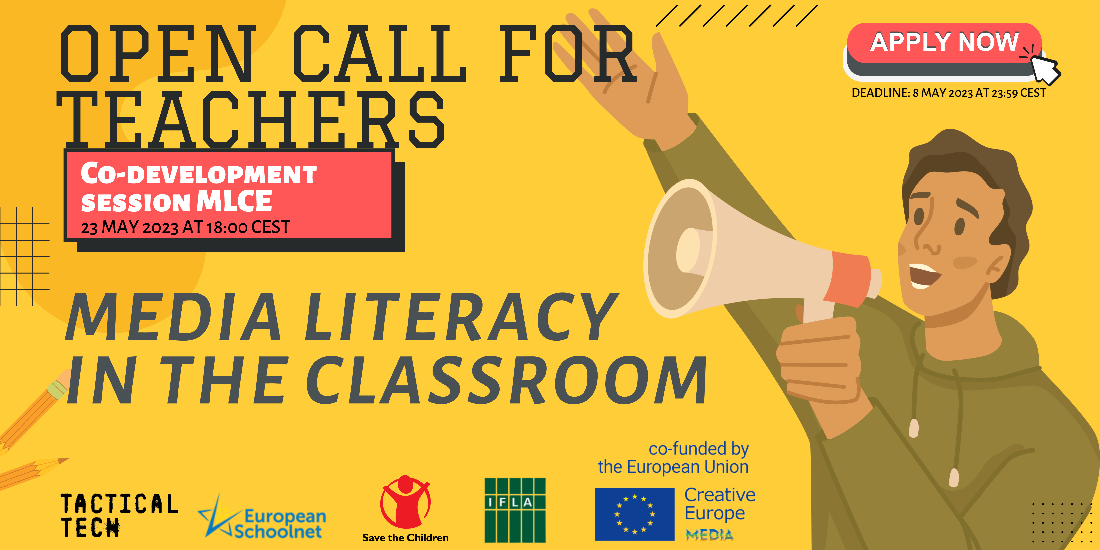
The Media Literacy Case for Educators (MLCE) project is looking for 25 teachers to participate in a co-development session on Tuesday, 23 May at 18:00 CEST. The aim of the session is to explore the most effective approaches and resources used to teach media literacy to youth, as well as identify the needs of teachers to enhance media literacy in young people. Express your interest in participating in the session by completing the application form by Monday, 8 May 2023; for more information please visit the European Schoolnet website.
Image credit: EUN
|

|
|

|
|
|
|
|
|
|
Events and campaigns
|

|
|
All Digital Weeks 2023
|
|
All Digital Weeks is an annual digital inclusion and empowerment campaign run at digital competence centres, libraries, community centres, schools and other venues across Europe. Every year it helps 100,000 Europeans to learn and be inspired by what technology can do for them. All Digital Weeks encourages various activities to support those Europeans who do not have enough digital skills to participate fully in society and benefit from digital transformation.
All Digital Weeks 2023 will take place 17 April - 7 May 2023. Anyone can join the campaign by organising an online/offline event, training, workshop or relevant activity, and highlighting it on the campaign's interactive map. Find out more at alldigitalweeks.eu.
|

|
|
|
|
|
|
And finally...
|

|
|
Look out for the next BIK bulletin mailing...
|
|
Can you believe, we are already fast approaching the first anniversary of the adoption of the new European strategy for a Better Internet for Kids (BIK+) which aims to improve age-appropriate digital services and to ensure that every child is protected, empowered and respected online. Adopted in May 2022, the BIK+ strategy strives for accessible, age-appropriate and informative online content and services that are in all children's best interests.
Look out for a 'BIK bulletin extra' mailing in mid-May where we'll bring you a brief recap of progress to date and an update on the next steps.
|

|
|
|
|
Under the Connecting Europe Facility (CEF), the European Commission (EC) has co-funded a range of better/safer internet services, both at the European and the national level. Building on the European Strategy for a Better Internet for Children (BIK strategy) as published in 2012 and the updated BIK+ strategy published in May 2022, the BIK core service platform aims to bring together European stakeholders in the field to work collaboratively in achieving the goal of a better internet for all. In the future, actions will be funded through the Digital Europe Programme (DIGITAL). This bulletin is just one of a range of tools and services provided. Keep following us across all BIK communication channels – see links in the header of this email.
The Better Internet for Kids (BIK) bulletin is compiled and issued by the BIK Coordination Team at European Schoolnet (EUN) on behalf of the European Commission. In case of comments or queries, please contact bulletin@betterinternetforkids.eu.
If you no longer wish to receive the BIK bulletin, please unsubscribe here. You can review your personal data on your profile page.
If this email was forwarded to you, subscribe here.
The European Commission is committed to personal data protection. Any personal data is processed in line with the Regulation (EU) 2018/1725. Please read the BIK bulletin privacy statement.
Visit www.betterinternetforkids.eu for the latest news and information on keeping children and young people safe online.
|
|
ISSN: 2600-5360
|
Catalogue Number: KK-BD-23-001-EN-Q
|
|
 |
|